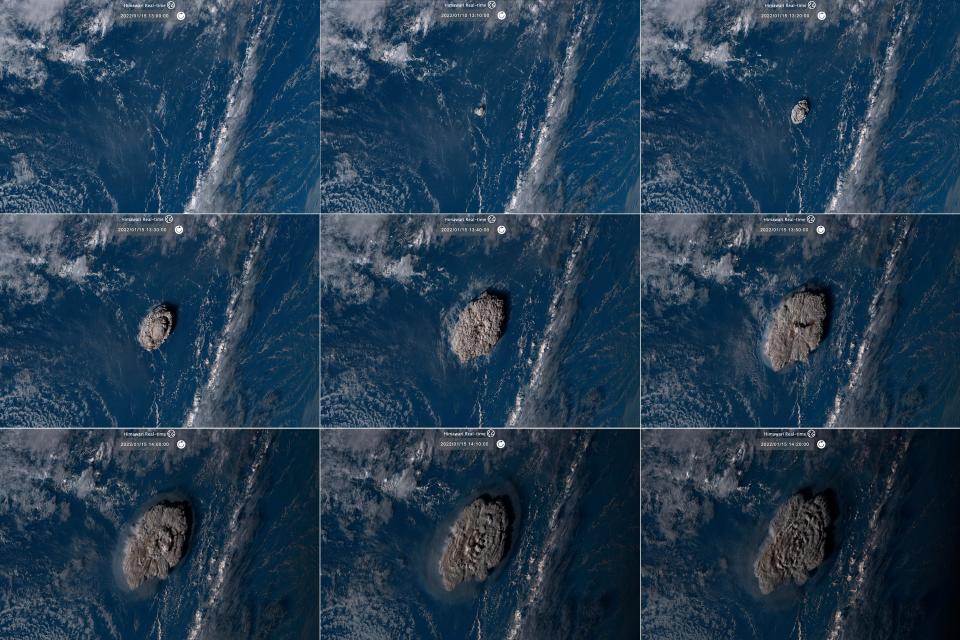Tonga volcano eruption was the biggest in over a century and it reached space, studies say
The volcanic eruption that discharged near Tonga in January – which caused destruction to the nation and was felt by other countries along the Pacific Ocean – was one of the most powerful eruptions in the last century and reached to the edge of space, new research revealed.
The Hunga Tonga-Hunga Ha'apai underwater volcano, around 40 miles north of the Tongan capital of Nuku'alofa, erupted on January 15, creating powerful tsunami waves and covering much of the Pacific nation in ash, destroying homes and killing at least three people.
The impact was so strong, it severed the single underwater fiber-optic cable that connects Tonga to the rest of the world, and U.S. officials warned West Coast residents of tsunami waves hitting Pacific beaches.

The eruption also sent atmospheric shock wave and sonic booms across the globe, but a new study published in Geophysical Research Letters on Tuesday showed the effects also reached into space.
Using data from NASA’s Ionospheric Connection Explorer and satellites from the European Space Agency, researchers found in the hours after the eruption, it generated hurricane-like winds and "unusual electric currents" in the ionosphere, Earth's upper atmospheric layer over 60 miles in the air at the edge of space.
"This is something we’ve only previously seen with strong geomagnetic storms," Joanne Wu, co-author of the study and physicist at University of California, Berkeley, said in a statement.
Hunga Tonga-Hunga Ha'apai volcano: The tremendous explosion and impact of the Tonga volcano, explained
More: Olympian Pita Taufatofua – the viral shirtless Tongan – helps country recover from volcano
Volcano effects: Before and after images show Tonga smothered in ash after volcanic eruption causes tsunami
The volcanic eruption pushed out a massive plume of gases, water vapor and dust into the sky, as well creating strong winds in Earth's atmosphere. As the winds moved upwards, they became faster due to the thinning atmospheric layers. By the time the winds reached the ionosphere, they were traveling at 450 miles per hour, well over the equivalent of a Category 5 hurricane.
"The volcano created one of the largest disturbances in space we’ve seen in the modern era," said Brain Harding, lead author of the study and physicist at University of California, Berkeley.
Not only was it one of the largest disturbances in space, but also on Earth, as a separate study published in the journal Science on Thursday said the Hunga eruption was the most powerful volcanic eruption since the Krakatoa eruption in 1883.
The Krakatoa eruption off the Indonesian islands in 1883 is one of the deadliest volcanic eruptions in history, as over 36,000 people were killed.
Researchers compared the two eruptions by measuring the behavior of Lamb waves, which are the most dominant atmospheric pressure waves created by volcanic eruptions. They are low frequency waves that travel at the speed of sound, and depending on the size of explosion, they can last up to several hours.
Data revealed the Lamb waves from the Hunga eruption circled the planet one direction four times and went in the opposite direction three times, the same as the Krakatoa eruption.
“This atmospheric waves event was unprecedented in the modern geophysical record," Robin Matoza, lead author of the study and associate professor at the University of California, Santa Barbara, said in a statement.
Researchers said the findings will lead into further studies into the effects of the eruption, as the Hunga eruption gave them the first modern set of data for such a massive explosion.
"The 2022 Hunga event provided an unparalleled global dataset for an explosion event of this size," Matoza said. "As a community, we will be working further on this event for years."
Follow Jordan Mendoza on Twitter: @jordan_mendoza5.
This article originally appeared on USA TODAY: Tonga volcano eruption most powerful in over 100 years, reached space

